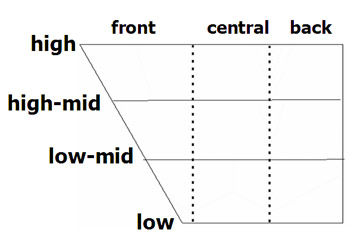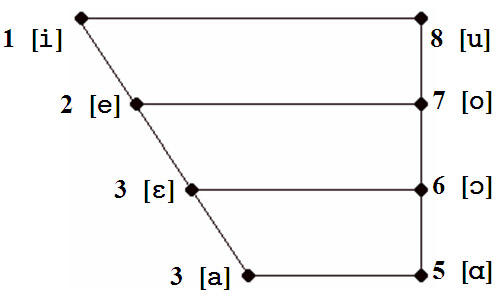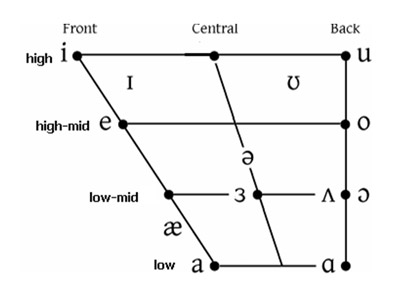Vowels are sonorous, syllabic sounds made with the vocal tract more open than it is for consonant and glide articulation.
Different vowel sounds (also called vowel qualities) are produced by varying the placement of the body of the tongue and shaping the lips.
Vowel articulations are not as easy to feel as consonant articulations at first, since the vocal tract is not narrowed as much.
To begin with, we will assume that all vowels are voiced and articulated with a constriction of open approximation.
We will also assume (for the moment) that all vowels are oral sounds.
The range of positions which the tongue can occupy within the oral cavity while remaining in a constriction of open approximation is quite large.
The entire available space for such articulation is called the vowel space.
The vowel sounds are represented on an idealized chart of this space
In this diagram, the vowel space is represented along two dimensions:
– high / low dimension (vertical axis):
depicting the height of body of the tongue during articulation of a vowel – i.e. depicting vowel height
(This is also referred to as the close/open dimension – depicting the openness of the oral cavity during articulation)
Four arbitrary points may be identified along this dimension – high, high-mid, low-mid and low
– front / back dimension (horizontal axis):
depicting the extent to which the body of the tongue lies towards the front of the vowel space
Three arbitrary points may be identified along this dimension – front, central and back
Thus, using these two dimensions, we can say, for any given vowel, how high in the vowel space it is articulated, and whether it is a front, central or back vowel.

CARDINAL VOWELS
In addition to these two descriptive parameters, a third is added, which refers to lip position – for a given vowel, it should be said whether, during articulation, the lips are rounded or not.
8 arbitrary points plotted along the perimeter of the vowel space represent the articulation of the cardinal vowels
These cardinal vowels are known both by the number and symbol.
This vowel quadrilateral and the cardinal vowel system were developed in 1956 by Daniel Jones – a British phonetician.
Cardinal vowels are an arbitrary set of reference vowels – arbitrary in the sense that there is no apparent reason why there should be 8 rather than 10 or 12 or any other number.
They are peripheral vowels – they define the boundary of the space within which vowels can be produced.
Therefore cardinal vowels are not exemplified with words from English, or any other language, since, typically, speakers do not utter vowel sounds which are quite as peripheral in the vowel space as the cardinal vowels.
THE 8 CARDINAL VOWELS
Cardinal vowel number: 1
Articulation: Lips are unrounded, tongue located as high and as front as possible, without causing friction, in the vowel space
IPA symbol: 
Description: high front unrounded vowel
Cardinal vowel number: 2
Articulation: Lips unrounded, tongue as far front as possible, in the vowel space, tongue at high-mid position
IPA symbol: 
Description: high-mid front unrounded vowel
Cardinal vowel number: 3
Articulation: Lips unrounded, tongue as far front as possible, in the vowel space, tongue at low-mid position
IPA symbol: 
Description: low-mid Front unrounded vowel
Cardinal vowel number: 4
Articulation: Lips unrounded, tongue as far front as possible, in the vowel space, tongue as low as possible in the vowel space
IPA symbol: 
Description: Low front unrounded vowel
Cardinal vowel number: 5
Articulation: Lips unrounded, tongue as far back as possible, in the vowel space, tongue as low as possible in the vowel space
IPA symbol: 
Description: Low back unrounded vowel
Cardinal vowel number: 6
Articulation: Lips rounded, tongue as far back as possible, in the vowel space, tongue at low-mid position
IPA symbol: 
Description: low-mid rounded back vowel
Cardinal vowel number: 7
Articulation: Lips rounded, tongue as far back as possible, in the vowel space, tongue at high-mid position
IPA symbol: 
Description: high-mid rounded back vowel
Cardinal vowel number: 8
Articulation: Lips rounded, tongue as far back and as high as possible, in the vowel space, without causing friction
IPA symbol: 
Description: High back rounded vowel

English Vowels
Simple / Pure Vowels
English vowels are divided into two major types – simple vowels (also know as pure vowels or monophthongs) and diphthongs.
Simple vowels do not show a noticeable change in quality.
Diphthongs
Diphthongs are vowels that exhibit a change in quality within a single syllable.
English diphthongs show changes in quality that are due to tongue movement away from the initial articulation towards another vowel position.
This change in vowel quality is clearly perceptible.
Triphthongs
Triphthongs are monosyllabic vowel combinations usually involving a quick, but smooth movement from one vowel to another that passes over a third one.
Tense and Lax vowels
Tense vowels are produced with a placement of the tongue that results in greater vocal tract constriction and are, in general, longer.
Lax vowels may be made with roughly the same tongue position as their tense counterparts but with less constricted articulation.
Not all the vowels come in tense/lax pairs.
ENGLSIH VOWELS


Will you kindly favour me with the phonetic description of the vowel in the English word ‘sit . Is it correct to describe it as high front unrounded vowel?
Hi Shreyas, the high front unrounded vowel is [i], as in the English word /sit/ (spelled as ‘seat’) and the vowel you ask about could best be described as a near-high, near-front unrounded vowel. Hope that’s useful. Cheers 🙂
That is quite insightful. It provided me several ideas and I’ll be placing them on my web site eventually. I’m bookmarking your site and I’ll be back. Thank you again!